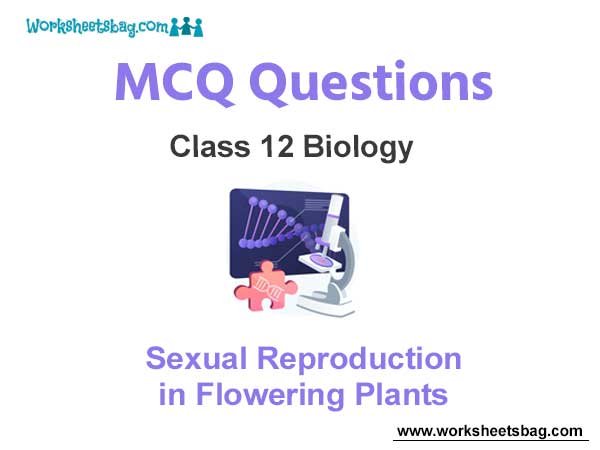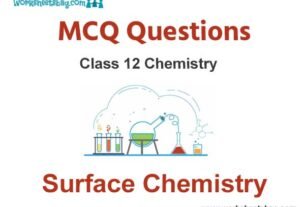Please refer to Sexual Reproduction in Flowering Plants MCQ Questions Class 12 Biology below. These MCQ questions for Class 12 Biology with answers have been designed as per the latest NCERT, CBSE books, and syllabus issued for the current academic year. These objective questions for Sexual Reproduction in Flowering Plants will help you to prepare for the exams and get more marks.
Sexual Reproduction in Flowering Plants MCQ Questions Class 12 Biology
Please see solved MCQ Questions for Sexual Reproduction in Flowering Plants in Class 12 Biology. All questions and answers have been prepared by expert faculty of standard 12 based on the latest examination guidelines.
MCQ Questions Class 12 Biology Sexual Reproduction in Flowering Plants
Question- Which of the following Paris las Laploid number of chromosomes
(a) Nuclellus and Antipodal cells
(b) Egg nucleus an secondary nucleus
(c) Megaspore moker cell Egg nucleus
(d) Egg cell and artipodal cells
Answer
D
Question- An obligate association between flower and pollinating agent is found in
(a) Yucca
(b) Maize
(c) Cosmos
(d) Arena
Answer
A
Question- Which of the following is false false?
(a) Flowers do not exist only for us to be used for our own selfishness
(b) All flowering plants show sexual reproduction
(c) Gymnosperms, being nonflowering, do not show sexual reproduction
(d) Flowers are objects of aesthetic, ornamental, social, religious and cultural value
Answer
C
Question- Pollination by snail and slug in known as-
(a) Ornithophilous
(b) Chiropterophilous
(c) Entomophilous
(d) Malacophilom
Answer
D
Question- Which of the following sequences of development of embryo sac / female gametophyte is correct?
(a) Nucellus —> Megaspore —> Embryo sac
(b) Nucellus —> Megaspore mother cell —> Megaspore —> embryo sac
(c) Nucellus —> Megasporangium —> Megaspore —> Embryo sac
(d) Nucellus —> Megagametophyte —> Megaspore —> Embryo sac
Answer
B
Question- Which of the following statements is false?
I. Pollen grains represents immatured male gametophyte
II. In angiosperms partially developed male gametophytes are pollinated
III. Generative cell is siponogenous while vegetative cell is spermatogenous
IV. Formation and differentiation of pollen grains is called microsporogenesis
V. Hay fever is a pollen allergy
VI. Pollen grains of some plants produce severe allergy and respiratory or bronchial diseases
VII. Pollen grains are poor in nutrients.
(a) I and VII
(b) III and VII
(c) IVandV
(d) VI and VII
Answer
C
Question- Emasculation is not required when flowers are
(a) Bisexual
(b) Intersexual
(c) Unisexual
(d) Either a or b
Answer
C
Question- Which of the following has the least pollen viability?
(a) Cereals like wheat and rice
(b) Members of Rosaceae
(c) Members of Leguminoseae
(d) Members of Solanaceae
Answer
A
Question- Subterranean Cleistogamous and geophilous flowers occur in
(a) Viola
(b) Commelina
(c) Ficus bengalensis
(d) Anthocephalus
Answer
B
Question- Embryo sac is monosporic when it develops from
(a) One of the four megaspores of a megaspore mother cell (MMC)
(b) 3 megaspores of a megaspore tetrad
(c) 2 megaspores
(d) The MMC where meiosis has occured but cytokinesis does not take place
Answer
B
Question- Moth (Pronuba / Tegaticula) passes its larval stage in plant pollinated by it. The plant is
(a) Ficus
(b) Tagetes
(c) Cosmos
(d) Yucca
Answer
D
Question- An interesting modification of flavor shape for insect pollination occurs in some orchids in which a male insect mistakes the pattern an the orchid flower for the female of lin species and tries to copulate with it, thereby pollinating the flower, thin phenomena is called-
(a) Pseudopartherocary
(b) Mimicry
(c) Pseudopollination
(d) Pseudocopulation
Answer
B
Question- Unisexu ty of flower prevents
(a) Geitonogamy but not xenogamy
(b) Autogamy but not geitonogamy
(c) Autogamy and geitonogamy
(d) Both geitonogamy and xenogamy
Answer
B
Question- Pollen grains can be stored in liquid nitrogen at
(a) 70°C
(b) 100°C
(c) –196ºC
(d) 0º C
Answer
C
Question- Which one of the following produces both enzymes and Lemans
(a) Topetum
(b) Endothecium
(c) Middle layers
(d) Epidermis
Answer
A
Question- All of the following include outbreeding devices except
(a) Unisexu ty of flowers, self-incompatibility
(b) Pollen release and stigma receptivity are not synchronized
(c) Anthers and stigma are placed at different position
(d) Bisexu ty, homogamy, cleistogamy
Answer
D
Question- Which of the following points is incorrect about sporopollenin?
(a) It is one of the most resistant organic material known
(b) It can withstand high temperature and strong acids and alk
(c) 2 enzymes that degrade sporopollenin are known so far
(d) Pollen grains are well preserved as fossils because of presence of sporopollenin
Answer
C
Question- Thro ugh which cell of the embryo sac does the poller tube enter the embryo sac
(a) Egg cell
(b) Central cell
(c) Persistant symerfid
(d) Degenerated symergid
Answer
D
Question-The proximal part of filament of stamen is attached to –
(a) Thalamusorthepetal
(b) Sepals or thalamus
(c) Pedicel or petiole
(d) Ovary or ovule
Answer
C
Question- A homogamous tall pistillate plant (TT) is crossed with homogamous dwarf staminate plant (tt). What is the genotype of endosperm?
(a) TTT
(b) TTt
(c) Ttt
(d) ttt
Answer
B
Question- The female gametophyte /embryo sac of typical dicot (Polygonum) or monosporic embryo sac is –
(a) 7-celled and 7-nucleate
(b) 8-celled and 8-nucleate
(c) 7-celled and 8-nucleate
(d) 8-celled and 7-nucleate
Answer
C
Question- Microsporangium is generally surrounded by 4 wall layers. Which of the following 3 wa!l layers perform the function of protection and help in the dehiscence of anther to release the pollen?
(a) Epidermis, tapetum, endothecium
(b) Epidermis, aril, endothecium
(c) Epidermis, endodermis, mesocarp
(d) Epidermis, middle layer and ndothecium
Answer
D
Question- Autogamy is
(a) Transfer of pollen grains from anther to stigma of the same flower
(b) transfer of pollen grains from anther to stigma of another flower
(c) Pollination between two flower
(d) Maturation of anther and stigma at different times
Answer
A
Question- The largest cell in an embryo sac is
(a) Egg
(b) Central cell
(c) Synergid
(d) Antipodal cell
Answer
B
Question- Maturation of male and female sex organo at different times in known as
(a) Herkogamy
(b) Dichgamy
(c) Polygamy
(d) Apogamy
Answer
B
Question- In which part of a flower do both meiosis and fertilization occur?
(a) ovule
(b) stigma
(c) anther
(d) petal
Answer
A
Question- Pollen tube enters the embryo sac usually
(a) By penetrating egg cell
(b) Through one degenerated synergid
(c) By destroying antipodal cells
(d) Between persistent synergid and central cell
Answer
B
Question- Transfer of pollen grains from anther to the stigma of another flower of same plant is
(a) Geitonogamy
(b) Xenogamy
(c) Autogamy
(d) Cleistogamy
Answer
A
Question-Embeyo sac in also know as-
(a) MIcrogametophyte
(b) Megagametophyte
(c) Microsporangium
(d) Megasporagium
Answer
B
Question- Majority of flowering plants
(a) Produce hermaphrodite flowers
(b) Are dioecious
(c) Show self-pollination
(d) Show autogamy
Answer
A
Question- Which of the following devices is not used by plants to prevent autogamy
(a) Self-incompatibility
(b) Production of unisexual flowers
(c) Heterostyly
(d) Production of Cleistogamous flowers
Answer
D
Question- Go through the following statements –
I. Flowers are bisexual and homogamous maturing anther and stigma of a flower at the same time.
II. Mechanical devices bringing anthers and stigma close together in a bisexual chasmogamous flower.
III. Cleistogamy (bisexual flowers remain closed)
IV. Anther and stigma of an intersexual flower mature, in bud condition. The above contrivances favour
(a) allogamy
(b) Autogamy
(c) Xenogamy
(d) Cross pollination
Answer
B
Question- In coconut liquid nuclear endosperm is surrounded by white kernel which is
(a) Integument/seed coat
(b) Cellular endosperm
(c) helobtel’endosperm
(d) fibrous mesocarp
Answer
B
Question-Cleistogamous flowers produces assured seed-set even in the absence of pollinator – why?
(a) Because they have fragrance
(b) Because they remain open
(c) Because they are autogamous
(d) Because they are colourful
Answer
C
Question- Egg apparatus of an embryo sac consists of
(a) Egg cell only
(b) Egg cell + 3 antipodal cells
(c) One oosphere (egg) + 2 synergids
(d) One oosphere (egg) + 2 synergids + 2 antipodal cells
Answer
C
Question- Which of the following sequences is correct for microsporogenesis?
(a).Micro S.M.C (2N) Mltosis> Microspore tetrad (2N) Meios’V Microspore (N)
(b) Micro S.M.C (2N) ————> Microspore tetrad (N) ———> Microspores (N)
(c) Microspore tetrad (2N)— OSIS> Microspores
(d) Micro S.M.C (2N) MltOSIS> Microspore tetrad (2N) Mltosis» Microspores (2N)
Answer
B
Question-In typical embryo sac, the nuclei are arranged as –
(a) 3 + 2+ 3
(b) 3 + 3 + 2
(c) 2 + 3 + 3
(d) 2 + 4 + 2
Answer
A
Question- The root cell of wheat plant has 42 chromosomes what would be the number of chromosomes in the synergid cell
(a) 7
(b) 14
(c) 21
(d) 28
Answer
C
Question- In angiosperms pollination occurs when pollen grains are in
(a) 2-celled stage
(b) 3-celled stage
(c) 2 or 3 celled stage
(d) Uninucleate stage
Answer
C
Question- Which of the following statements is correct.
(a) Majority of plants use biotic agents for pollination
(b) Pollination by wind is more common among abiotic pollinations
(c) Pollination by water is quite rare in flowering plants
(d) AII
Answer
D
Question- Contrivance for self-pollination/autogamy is
(a) Homogamy
(b) bisexu ty
(c) Cleistogamy
(d) AII
Answer
D
Question- Double fertilization in unique be
(a) Pteridophytes
(b) Bryophytes
(c) Symmnosperms
(d) Angiosperm
Answer
D
Question-Which of the following plants produce(s) chasmogamous and Cleistogamous flowers?
(a) Viola (Common pansy)
(b) Oxa//s
(c) Commelina
(d) AII
Answer
C
Question- Which of the following statements is false about filiform apparatus?
(a) The synergids have special cellular thickenings at the micropylar tip called filiform apparatus
(b) It plays an important role in guiding the pollen tubes into the synergid
(c) Both
(d) Pollen tube stimulates the formation of filliform apparatus
Answer
D
Question- The process whereby a perfect flower is pollinated by its pollen is called
(a) Allogamy
(b) Autogamy
(c) Xenogamy
(d) Hydrogamy
Answer
B
Question- The term pollination signifies –
(a) Dehiscence of anther
(b) The transfer of pollen grains from anther to stigma
(c) The transfer of pollen grains from anther to the stigma of the same flower
(d) Formation of pollinia
Answer
B
Question- The development of fruit without fertilisation is
(a) Parthenogenesis
(b) Parthenocapy
(c) Apomixis
(d) Apogamy
Answer
B
Question- Select the connect order of endosperm types.
(a) Cellular, helobial, free nuclear
(b) Cellular, free nuclear Lelobial
(c) Helobial, free nuclear, cellular
(d) Free nuclear, cellular, helobial
Answer
B
Question- After triple fusion central cell changes into
(a) Embryo
(b) Embryo sac
(c) Primary endosperm cell (PEC)
(d) Primary endosperm nucleus
Answer
C
Question- In nature, allogamy is met within ________ surely
(a) unisexual flowers
(b) Neuter flowers
(c) Underground flowers
(d) Bisexual flower
Answer
A


